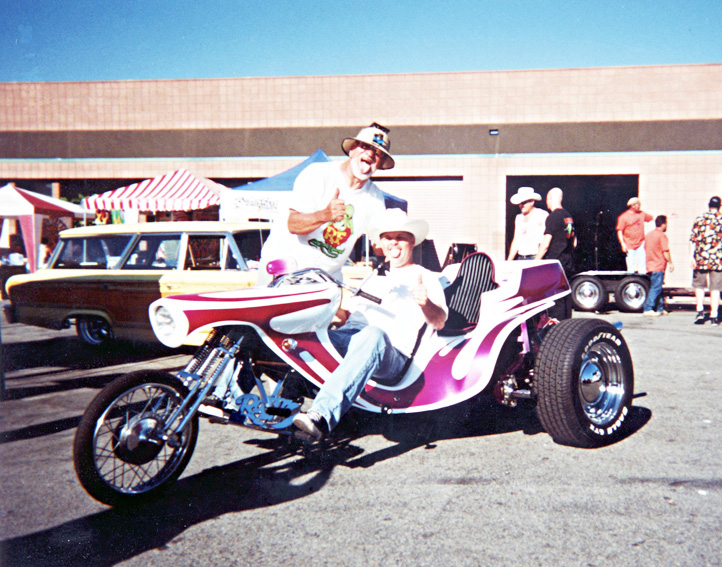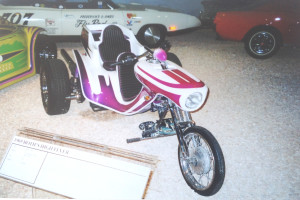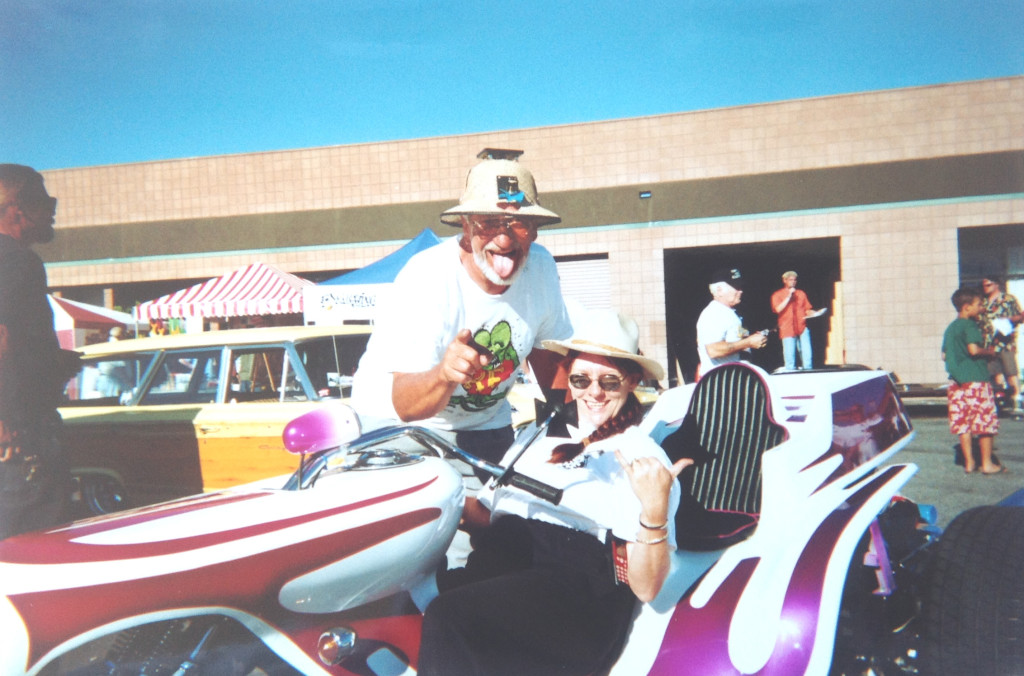
ED ROTH’S 1969 “HIGH FLYER” was donated to the National Automobile Museum in Reno, Nev., where it suffered serious damage in a fire last week. Experts say the trike can be restored again. Above, Roth and Ken Mitchroney (seated) with the High Flyer in 2000.
Photos courtesy Ken Mitchroney
Almost 30 years later, Roth’s sons, who had found and recovered the vehicle in the Southern California desert, sold it as-is to Ken Mitchroney, an artist who at the time was inking Roth’s penciled graphics.
Mitchroney hauled the battered fiberglass body and milk crates filled with parts north to the narrow one-car garage of his Point Richmond apartment.
By the time he moved to Martinez six months later, the trike was almost done, a process that involved friends, family members and several Bay Area experts in their respective fields.
Mitchroney and his assembled team had a deadline to beat. They wanted to show the completed trike to Roth at the inaugural Rat Fink Party Kustom Kulture Extravaganza, Klassic and Kustom Car Show slated for June 24, 2000, in North Hollywood.
When Mitchroney pulled into the show area to show Roth the completed trike, Roth promptly named it “The High Flyer” and told Mitchroney, “It looks even better than when it came out of my shop in ’69.”
Since Dec. 20, 2001, the trike has been the property of the National Automobile Museum in Reno, Nev., where it’s been on display among other of Roth’s high-concept vehicles.
But now the trike has been damaged, the victim of arson after someone threw a rock through a glass wall and then tossed an ignited bottle of flammable liquid through the opening.
The museum issued a statement Saturday about the fire, which broke out before 3 a.m. Friday in its outer lobby.
“The incident caused limited damage to the building as well as (to) the Ed Roth Custom Trike on display near the main entrance,” the statement said. “There were no injuries, and though the cause of the fire is unknown, an investigation is under way.”
The museum has been closed since the incident, and while staff had hoped to reopen the building by midweek, a news release Tuesday said the closure has been extended because of air quality issues and other cleanup operations.Employees said they hope to reopen the museum this weekend, though repairs may take longer.
Reno Fire Department officials have been gathering evidence at four Reno fire scenes, including the museum, since June 13, and said all appear to be related and to have been set deliberately.
Based on that evidence, including videos, Reno police arrested a suspect they believed was involved in the four fires. He was identified as Timothy Gray, 47, and has been charged with first- and third-degree arson and booked into Washoe County Jail in Nevada.
In a written statement, Reno police Capt. Tray Palmer said, “We are pleased to report (to) the community that we believe the threat from this arsonist has been resolved as a result of the arrest. We are grateful to members of the public who provided us with information leading to the arrest.”
Jackie Frady, executive director of the National Automobile Museum, said she planned to contact Mitchroney about the fire and send him pictures.
“I thought of him the instant I saw the trike,” she said. “There is so much to get the museum back in operation.”
Frady said the trike suffered “moderate” damage, particularly to its right rear area.
But, “Yes, it can be restored,” she said.
Mitchroney heard about the trike’s damage Saturday from Dave “Hot Rod” Shehorn, a Concord pinstriper.
“It’s sickening,” Mitchroney said. “It gave me a sick feeling in the pit of my stomach.
“I don’t own it anymore. We donated it on Ed Roth’s death. But it’s wrong,” he said. “You do all this to get the vehicle up and running, and this idiot does this. Of course you feel bad about it.”
The arsonist did more than damage The High Flyer, Mitchroney said. That fire also harmed the National Automobile Museum.
“It’s a tragedy to the museum on a lot of levels,” he said. “You can’t restore a week of the museum being closed.
“I’m more upset that the museum lost the revenue. This is wrong on a lot of levels. Just because I donated the trike doesn’t mean I’m not connected.”
He said he’s been “a very big supporter of this museum” since Roth handed him the executive director’s business card and urged Mitchroney to send the trike there when he was done “playing around” with it.
The fire suppression sprinklers that saved most of the museum and its contents also caused minor damage to a DeLorean in the collection. But it could have been much worse, Mitchroney said.
“(The arsonist) could have lit the Beatnik Bandit on fire,” he said. Had that happened, the perpetrator would have faced the ire of “me and a thousand other fans” who admire Roth’s handiwork.
“I’m glad it wasn’t the Beatnik Bandit. If I had to take the hit to save the Beatnik Bandit, I’d take it,” Mitchroney said.
Roth and ‘Rat Fink’
Roth, listed among the museum’s supporters on its wall of contributors, was among the pioneers of Southern California’s “kustom kulture” and hot rod movement in the late 1950s and 1960s.
While in high school in Bell, he enrolled in both art and auto shop classes. He began cartooning wild “monster” and “weird-oh” characters driving hot rods with engines so overblown they couldn’t be contained under the hood. His most iconic character is the red-clad, warty “Rat Fink.”
Roth began airbrushing his characters on T-shirts and selling them in car magazines, then crafted his own silk screens for printing shirts.
Once fiberglass became commercially available, Roth began crafting unusual cars, beginning in 1959 with The Outlaw, then creating the Beatnik Bandit in 1961, the twin-engine Mysterion in 1963, the unusually lit Orbitron in 1964 and the Road Agent in 1965, the same year his tiny yellow surf buggy was featured in the teen film “Beach Blanket Bingo.”
Roth began customizing motorcycles in the middle of the 1960s, and published his own magazine that described how others could create choppers.
His venture into three-wheeled motorcycles, or trikes, is said to have started when a car beat out his motorcycle, though he quickly discovered that powering a trike with a V-8 engine was too hazardous. He then outfitted his trikes with Volkswagen engines.
The High Flyer has been described as “an excellent example” of the trikes Roth built in his shop in Southern California in the late 1960s to the early 1970s.
Unlike many of Roth’s three-wheel designs, which he popped from molds and sold as kits, The High Flyer was custom designed for Roth’s client, rumored to have been a wealthy drug dealer.
Dirty Doug, Roth’s ace body sculptor, started with one of Roth’s stock bodies. But he shaved it smooth and reshaped it into an unusual stealth design.
The trike features handle bars, custom springer forks and Roth foot pegs that became signatures of the Roth Studios’ designs of that era.
Restoring a masterpiece
As a youngster in Florida, Mitchroney was well aware of Roth and his cartoon and car designs. The two corresponded long before they met.
An artist himself, Mitchroney was inking comic books and breaking into animation when he and Roth met face to face in Southern California. Impressed with Mitchroney’s inking style, Roth brought him into his stable of artists, in particular since Roth didn’t like the way he inked his own drawings.
The two had been collaborators for some time when Mitchroney learned the old trike was available from Roth’s sons.
“We remember this one for sure,” said Dennis Roth and his brother, Reno. “We were there when Doug was grinding on the body.”

THE HIGH FLYER after last week’s fire in Reno. Police have arrested a suspect.
Photo courtesy National Automobile Museum
He called Roth and asked for advice on the restoration, and Roth provided plenty of information about the trike.
Since the job was too big for one man, Mitchroney assembled a skilled team. He handed the motor and rear end to Malcolm Wallace, a VW engine expert in Martinez. A neighbor, Bob “Yogi” McIntosh, sculpted new fiberglass parts that replaced missing pieces. Ken’s friends and family, including his parents, Joseph and Jeanne, who were vacationing from Florida, were recruited to work on the project, too.
Manuel’s Auto Body Shop in Vallejo painted the body, following the scallops that Mitchroney designed, inspired by some of Roth’s other paint schemes. The purple scallops on a body of white then were accented by pinstripes painted by veteran stripers Bud Thon and Greg “Coop” Cooper, and by Mitchroney himself.
Mitchroney tried to sculpt the seat the way Roth had done. Roth often would nap in a trike seat. If he was sore when he got up, he knew it needed more work. If he could awaken without any pain, he knew the seat was right.
The restoration was finished just before the show, and the trike made initial appearances at small exhibitions near Mitchroney’s home before he trailered it south, where Roth was waiting to see what Mitchroney had done.
After praising the restoration, Roth secretly entered the trike into the show’s competition, and Mitchroney went home with a prize. But he resisted Mitchroney’s repeated pleas to take a seat on the trike, to make sure the seat was right.
“If I sit on this trike, you’ll have to pick it up in New York,” Roth cautioned.
Later he would email Mitchroney, “Thanks for all the help! I dub the the trike KING of Rothdom! … Ed.”
The trike was valued at $35,000 by appraiser Joseph L. Troise of Sausalito at the time it was donated to the museum, the place Roth told Mitchroney he wanted it displayed.
The museum is where several of Roth’s other unusual fiberglass show vehicles can be seen — the 1961 Beatnik Bandit, 1994’s Beatnik Bandit II, the Conastoga Star, the Fink Mobile and the Yankee Blitz.
After Roth’s death on April 4, 2001, Mitchroney complied with Roth’s wishes. He called the museum as well as Roth’s widow, Ilene, to arrange the donation.
Mitchroney, who is working away from home as a storyboard artist at Warner Brothers Studios, hasn’t visited the trike since it’s been burned.
But he’s seen the photograph posted at the museum’s website, www.automuseum.org/blog/museum-closed-due-arson-fire-closed-due-arson-fire.
“It doesn’t look like the chrome got scorched, but I don’t know from that one photo,” he said. The left side appears undamaged, he said, though he said some lettering may need to be redone.
“It’s going to be restorable,” Mitchroney said. “They’ve got to grind it down to the gel coat and put new tires on the far side. Hopefully the frame did not get damaged.”
He said the trike’s cowling may need to be touched up, too.
“The good thing about a vehicle, you can put her back together,” Mitchroney said. “We’re back restoring it the way we found it. It could have been a lot worse. It’s a doable restoration.
“Whatever she needs, we’re there for the museum,” he said. “We’re there for Jackie.”








Leave a Reply